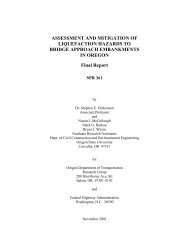Oregon Balance of State HIV/AIDS Housing & Services Systems ...
Oregon Balance of State HIV/AIDS Housing & Services Systems ...
Oregon Balance of State HIV/AIDS Housing & Services Systems ...
Create successful ePaper yourself
Turn your PDF publications into a flip-book with our unique Google optimized e-Paper software.
36 <strong>Oregon</strong> <strong>HIV</strong>/<strong>AIDS</strong> <strong>Housing</strong> and <strong>Services</strong> <strong>Systems</strong> Integration Plan<br />
Prisoner reentry issues are gaining more attention; however, there are still few resources available to<br />
people being released from prison and jail. Employers, landlords, subsidized housing providers,<br />
housing authorities, and even supportive housing programs <strong>of</strong>ten screen out people with criminal<br />
histories. Formerly incarcerated people may also be ineligible for public assistance, educational<br />
loans, and voting. Without employment or a place to live, successful reentry into the community is<br />
very difficult. 79<br />
Respondents to the stakeholder survey indicated that <strong>of</strong>fender transition services were an important<br />
need for the <strong>HIV</strong>/<strong>AIDS</strong> population. Half <strong>of</strong> respondents thought that reentry transition assistance<br />
was currently insufficient, and nearly half (47 percent) thought improving discharge planning from<br />
correctional facilities and hospitals was one <strong>of</strong> the highest priorities for systems integration to meet<br />
the needs <strong>of</strong> people living with <strong>HIV</strong>/<strong>AIDS</strong> across the state. While more than half <strong>of</strong> respondents had<br />
partnerships with criminal justice or transition services agencies, 44 percent felt that criminal justice<br />
or corrections agencies should be more involved in improving <strong>HIV</strong>/<strong>AIDS</strong> housing and service<br />
system integration.<br />
The prevalence <strong>of</strong> <strong>HIV</strong>/<strong>AIDS</strong> in the <strong>Oregon</strong> state prison population is estimated to be one to two<br />
percent, or approximately 225 persons; 80 additional people living with <strong>HIV</strong>/<strong>AIDS</strong> cycle through<br />
local jails. Ten percent <strong>of</strong> people living with <strong>HIV</strong>/<strong>AIDS</strong> in <strong>Oregon</strong> reported having spent time in jail<br />
or prison in the past two years. 81 Surveys by both DHS and Cascade <strong>AIDS</strong> Project found that<br />
housing needs and risk for homelessness were prevalent among clients with histories <strong>of</strong><br />
incarceration.<br />
With the support <strong>of</strong> the <strong>Oregon</strong> Department <strong>of</strong> Corrections (DOC), OHOP (as the grantee) and<br />
Cascade <strong>AIDS</strong> Project (as the sponsor) successfully applied for a HOPWA Special Project <strong>of</strong><br />
National Significance (SPNS) grant in 2006, creating the <strong>Oregon</strong> <strong>State</strong>wide Supportive Community<br />
Re-entry (OSSCR) program. As described above, OSSCR will serve up to 55 post-incarcerated<br />
people living with <strong>HIV</strong>/<strong>AIDS</strong> in <strong>Oregon</strong> per year over the three-year grant period with tenant-based<br />
rental assistance, housing information, and supportive services. OHOP has leveraged funds to<br />
complement $1.3 million in HOPWA award funds for a total <strong>of</strong> $3.1 million to serve both the<br />
Portland metropolitan area and <strong>Balance</strong> <strong>of</strong> <strong>State</strong>.<br />
Since 2003, the <strong>Oregon</strong> DOC has incorporated into its Strategic Plan an “<strong>Oregon</strong> Accountability<br />
Model” to promote successful transition by prisoners to the community after release. DOC included<br />
homelessness risk / housing need in its individual intake assessments for the first time in 2007, but<br />
does not currently provide housing assistance to any individuals released from DOC custody.<br />
Among the programs that DOC has implemented or partnered to implement to improve <strong>of</strong>fender<br />
reentry is the Home for Good in <strong>Oregon</strong> (HGO) transition program, a statewide partnership with<br />
faith- and community-based organizations and community corrections agencies in which volunteers<br />
assist and mentor released prisoners. 82 Pilot programs have been implemented in Marion, Linn,<br />
79 <strong>AIDS</strong> <strong>Housing</strong> <strong>of</strong> Washington, <strong>HIV</strong>/<strong>AIDS</strong>, Incarceration, and <strong>Housing</strong>, 2003. Available online:<br />
http://www.aidshousing.org/usr_doc/Incarceration_Factsheet_2003.pdf (Accessed: September 17, 2007).<br />
80 Unpublished voluntary recruitment <strong>HIV</strong> prevalence study by Portland <strong>State</strong> University, 2005 and surveillance data from Linda<br />
Drach, MPH, Epidemiologist, Program Design & Evaluation <strong>Services</strong>, <strong>Oregon</strong> DHS, May 2006, as reported in the 2006 SPNS<br />
application.<br />
81 <strong>Oregon</strong> Department <strong>of</strong> Human <strong>Services</strong>, Program Design and Evaluation <strong>Services</strong>. We Listened…2005: Survey for People Living<br />
with <strong>HIV</strong> and <strong>AIDS</strong> in <strong>Oregon</strong>. Available online: http://www.oregon.gov/DHS/ph/hiv/services/needs/reports.shtml (Accessed:<br />
November 27, 2007).<br />
82 <strong>Oregon</strong> DOC website, Transitional <strong>Services</strong> Division. Available online:<br />
http://www.oregon.gov/DOC/TRANS/religious_services/rs_hgo_program.shtml (Accessed: November 26, 2007).

















